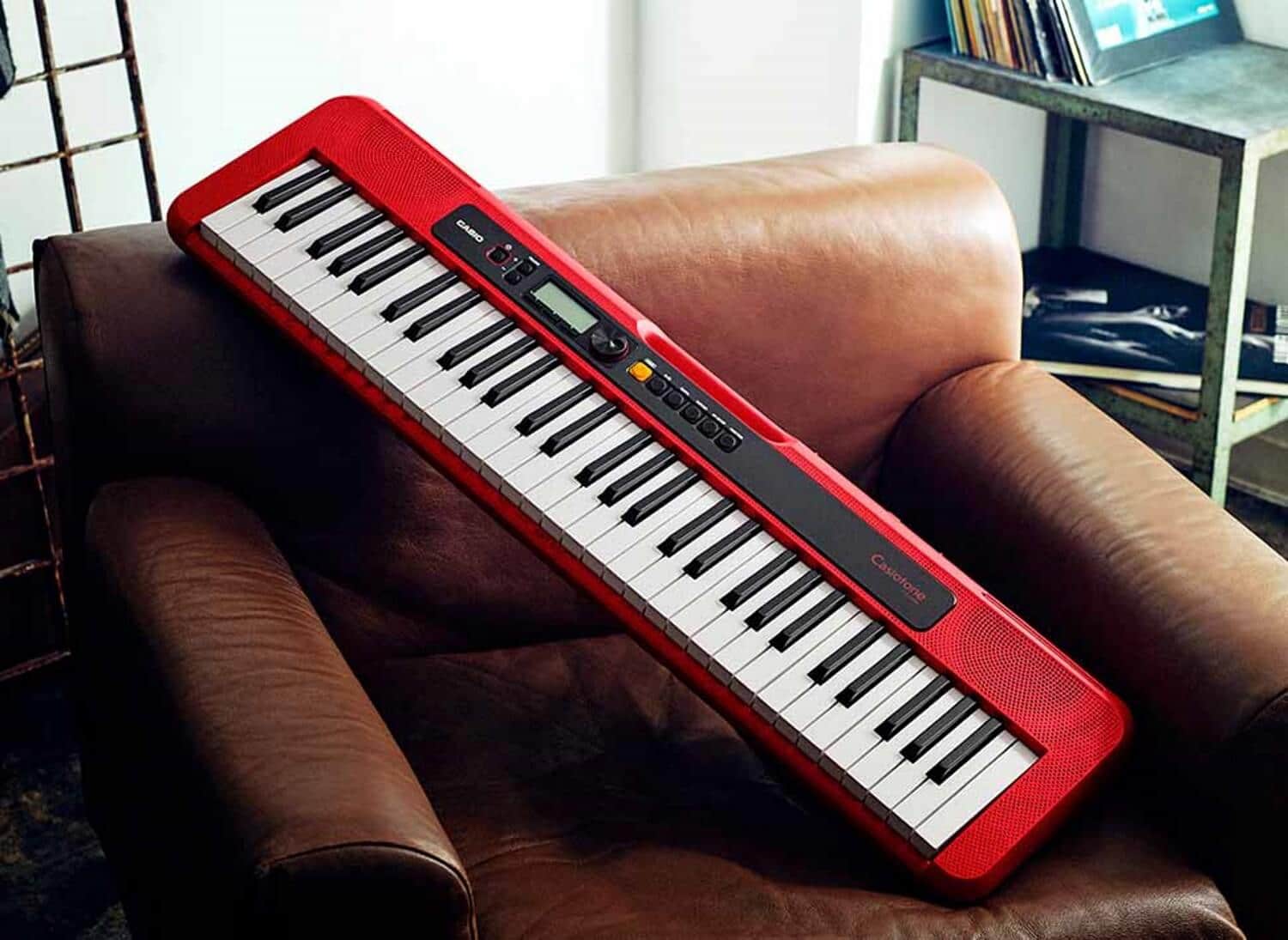
If you’re interested in playing the piano, you don’t need to go out and buy a baby grand for thousands of dollars. Instead, you can get the best Casio keyboard for a relatively affordable price and set it up anywhere in your home. Plus, Casio makes keyboards and digital pianos for a huge range of pianists and budgets.
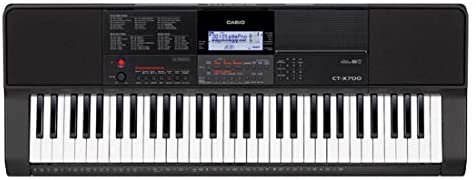

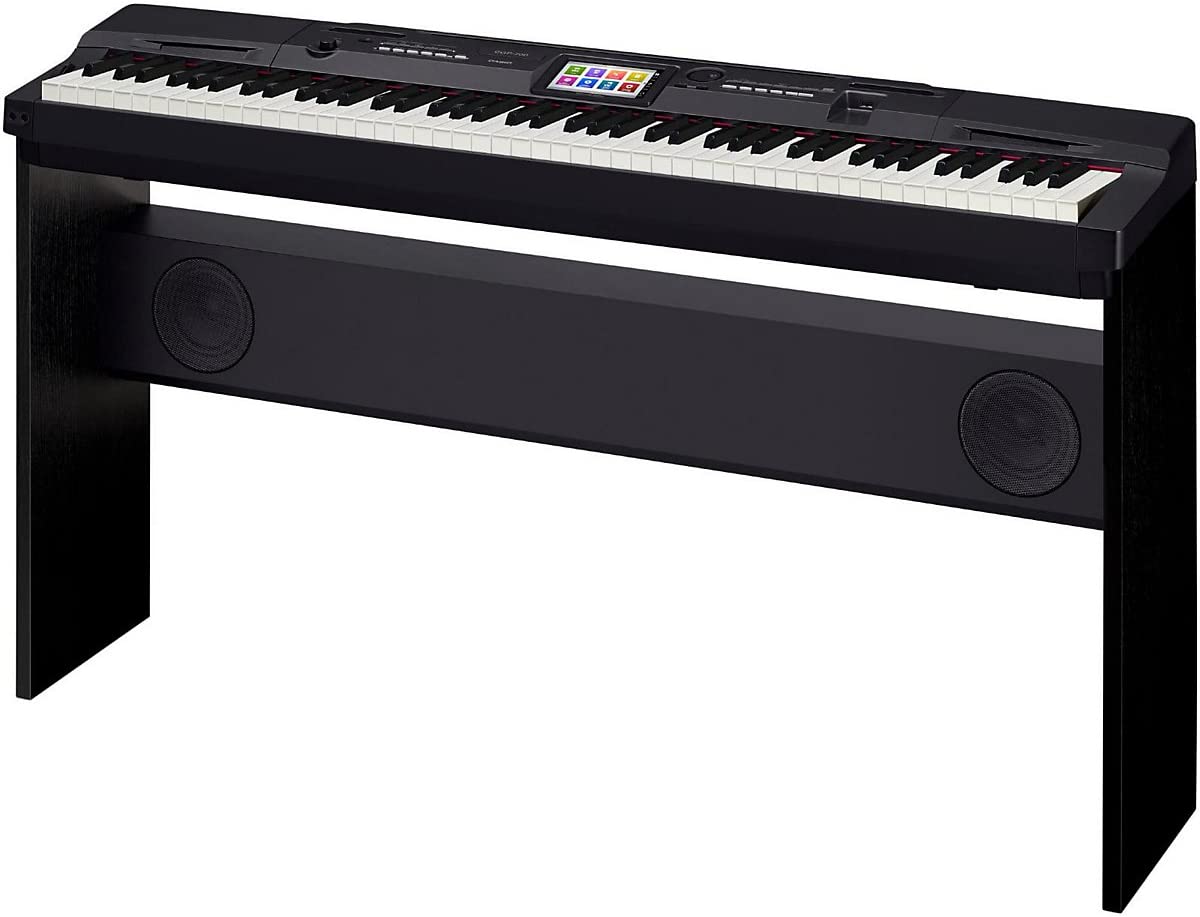

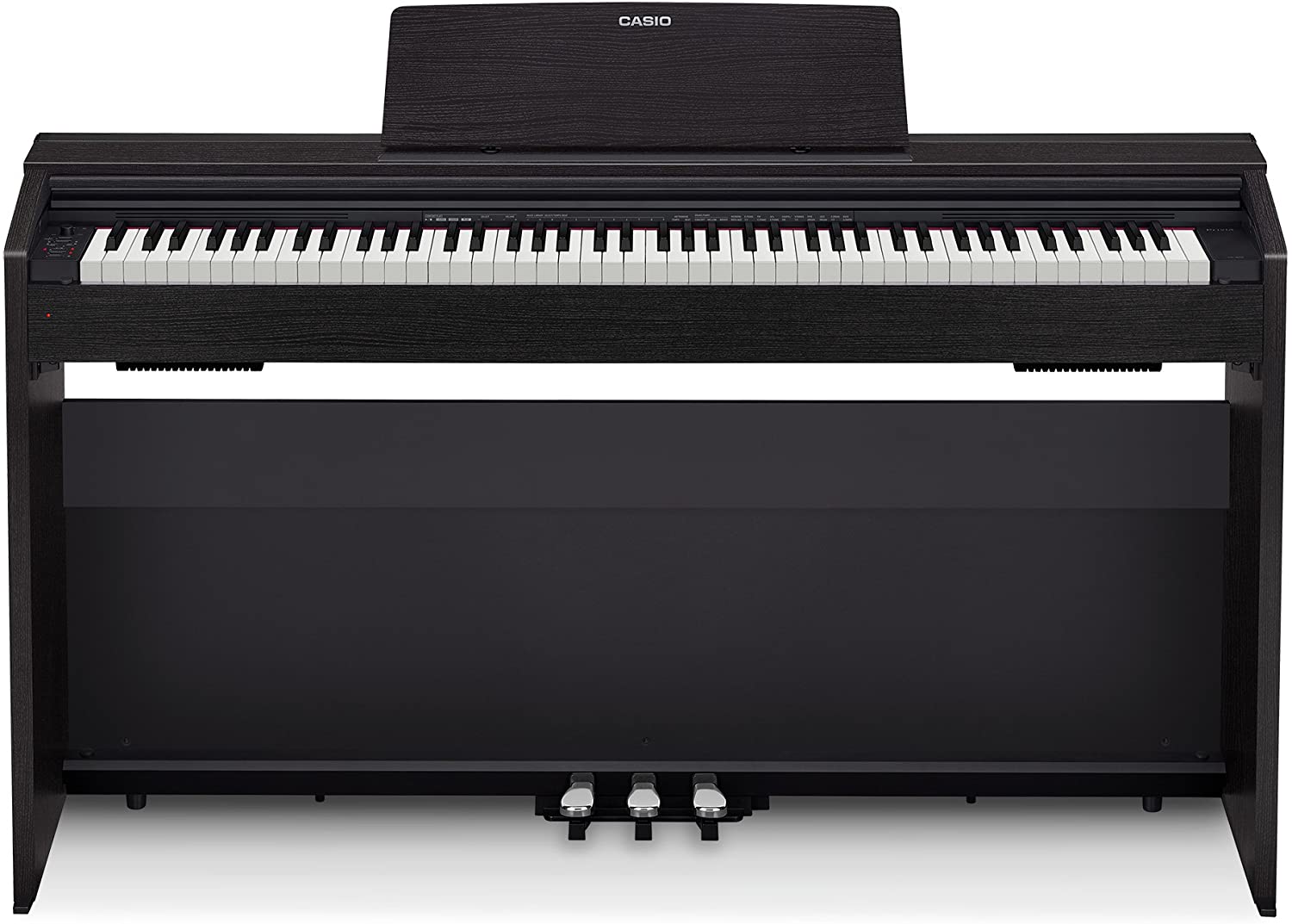

We considered a lot of factors when choosing the best Casio keyboards. The first thing we looked at was the size of the keyboard, which impacts the keyboard’s tonal range and the types of pieces you can play. We also considered polyphony, which is the number of notes that a keyboard can play at the same time. The size and weight of different keyboard models also played into our decision, since these impact how portable your Casio digital piano is. Read on to find complete reviews of the top 12 Casio keyboards.
| № | Name | Rating | |
|---|---|---|---|
| 1 | Casio CT-X700 |
9,9
|
Check price |
| 2 | Casio CGP-700 |
9,8
|
Check price |
| 3 | Casio Privia PX-870 |
9,7
|
Check price |
| 4 | Casio CT-S300 |
9,7
|
Check price |
| 5 | Casio Privia PX-770 |
9,6
|
Check price |
| 6 | Casio CT-X3000 |
9,6
|
Check price |
| 7 | Casio WK-6600 |
9,5
|
Check price |
| 8 | Casio PX-S1000 |
9,5
|
Check price |
| 9 | Casio CTK-2550 |
9,5
|
Check price |
| 10 | Casio SA-76 |
9,4
|
Check price |
| 11 | Casio LK-S250 |
9,4
|
Check price |
| 12 | Casio SA-46 |
9,3
|
Check price |
More features: AiX Sound Source; 100 built-in songs; lesson system; USB-MIDI port; 100 types of arpeggiator; 310 music presets; MIDI recorder

The Casio CT-X700 is the perfect mid-sized keyboard for a wide variety of users. It’s incredibly affordable and straddles the line between a keyboard and a digital piano.
To start, the 61-key keyboard has three different sensitivity levels and three different touch responses. So, it can feel a lot like a traditional acoustic piano if you’re in need of a portable alternative, or it can be as responsive as a light-touch keyboard.
Users also liked that the keyboard comes with a huge variety of built-in tones, sound effects, and rhythms. Casio included 100 built-in songs and 310 music presets, all of which can be accessed simply by entering the correct code using the display. The display itself is plenty bright, but users did point out that it has a narrow field of view.
An important thing to note for producers is that this keyboard supports MIDI recording. So, you can connect the keyboard to your computer with a USB and record music to nearly any major audio software. Users also appreciated that the keyboard is compatible with a pedal and has an input jack for an amplifier.
More features: stand with 6-speaker system; 5.3″ color touch interface; simulated ebony and ivory keys; compatible with the optional SP-33 pedal system

If you’re looking to make the jump from a basic keyboard to a high-end digital piano, the CGP-700 from Casio is a terrific option. This piano features a full 88-key keyboard with Casio’s tri-sensor scaled hammer action technology. The keys look and feel like traditional ebony and ivory keys, so you won’t be disappointed if you have experience with an acoustic piano. Plus, you can choose between three sensitivity levels to customize the feel.
Users also like the way that Casio crafted the control panel on this digital piano. It includes a 5.3-inch color touchscreen for easy control and navigation through the library of more than 550 tones. There’s also a dedicated button so you can quickly switch back to a standard grand piano sound at any time.
Perhaps unsurprisingly, this digital piano is one of the heavier offerings we reviewed from Casio. If you need something that stows away easily or that can be easily transported, this might not be the best choice for you.
More features: Powerful Sound Projection System; Multi-dimensional Morphing AiR; 99-song audio recorder/playback; 60-song music library + 10 user songs; simulated ebony and ivory keys

The Privia PX-870 is Casio’s flagship digital piano model. At just over $1,000, it’s an investment. But we think the cost is well justified by the construction quality and features for expert pianists looking for a digital alternative to a traditional piano.
This piano has a full 88-key board with weighted keys that perfectly mimic the look and feel of acoustic piano keys. You can also adjust between 3 sensitivity levels to dial in the responsiveness to pressure.
Casio didn’t include a lot of tones with this piano, since it’s largely meant to mimic the sound of an acoustic piano. However, it does support MIDI for recording songs to your computer, and it offers built-in memory for up to 99 songs. There’s also a 60-song music library.
The stand comes with 4 speakers that offer excellent sound projection and volume. There’s also a wooden cover to help keep the keys clean, and the piano includes pedals just like a traditional acoustic piano.
More features: 77 rhythms; 10 types of reverb; Dance Music Mode; USB-MIDI; Chordana Play iOS/Android app connection; easy-to-read LCD display; intuitive controls; 60 built-in songs; pitch bend wheel

The CT-S300 is one of the best Casio keyboards for anyone looking to break into basic music production. The keyboard includes 400 tones, 150 rhythms, and 10 different types of reverb. On top of that, Casio built a Dance Music mode for this keyboard that allows you to easily and quickly remix electronic music. There’s even a pitch bend wheel so that you can flexibly adjust the sound of your tones in real time.
The built-in speakers on this keyboard offer surprisingly high sound quality, so most users will be able to get away without connecting external speakers. If you want to connect larger speakers, the keyboard has a standard amp cable input. In addition, this keyboard connects to your computer and support MIDI for track recording.
More features: Multi-dimensional Morphing AiR; Chordana Play app compatible; simulated ebony and ivory keys; 60-song library + 10-song extensions; powerful stereo amplification system; Duet Mode; interactive learning and scoring system
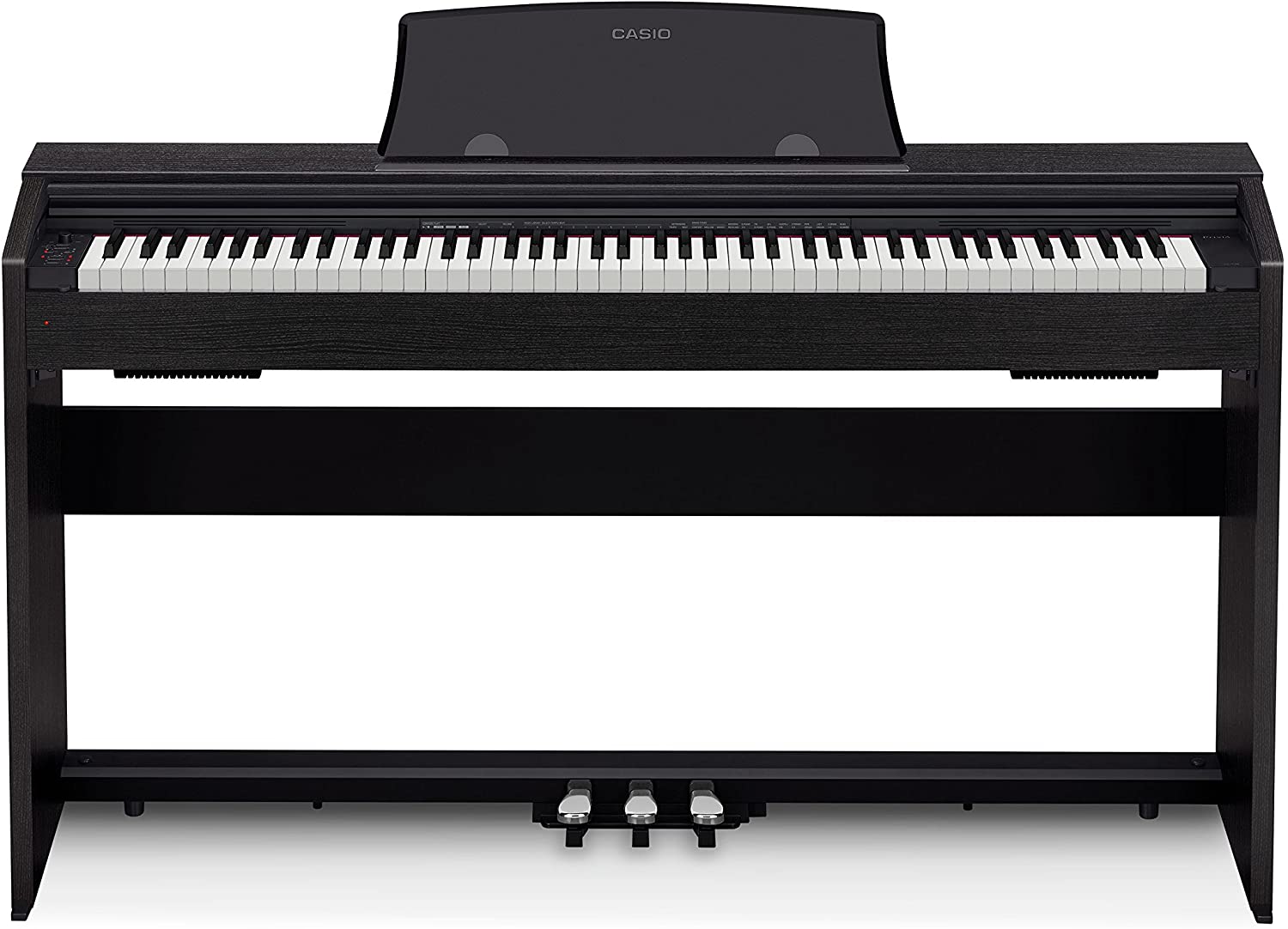
The Privia PX-770 is one of the most affordable digital pianos that Casio offers. This piano doesn’t cut many corners, as it features a full 88-key board with weighted keys using scaled hammer action technology. You can also adjust the keys between three sensitivity levels to dial in the perfect feel.
Users loved the sound of this piano, which is boosted by Casio’s multi-dimensional morphing AiR acoustics. It also has a powerful stereo speaker system built in, so you don’t need to worry about adding an external amp if you’re playing at home.
This digital piano has a handful of features for beginners. For example, Duet Mode enables a teacher and student to play side by side on the same keyboard. There’s also a library of songs that you can play along with to practice your skills.
More features: editable tones and rhythms; AiX Sound Source; 30 built-in songs; lesson function
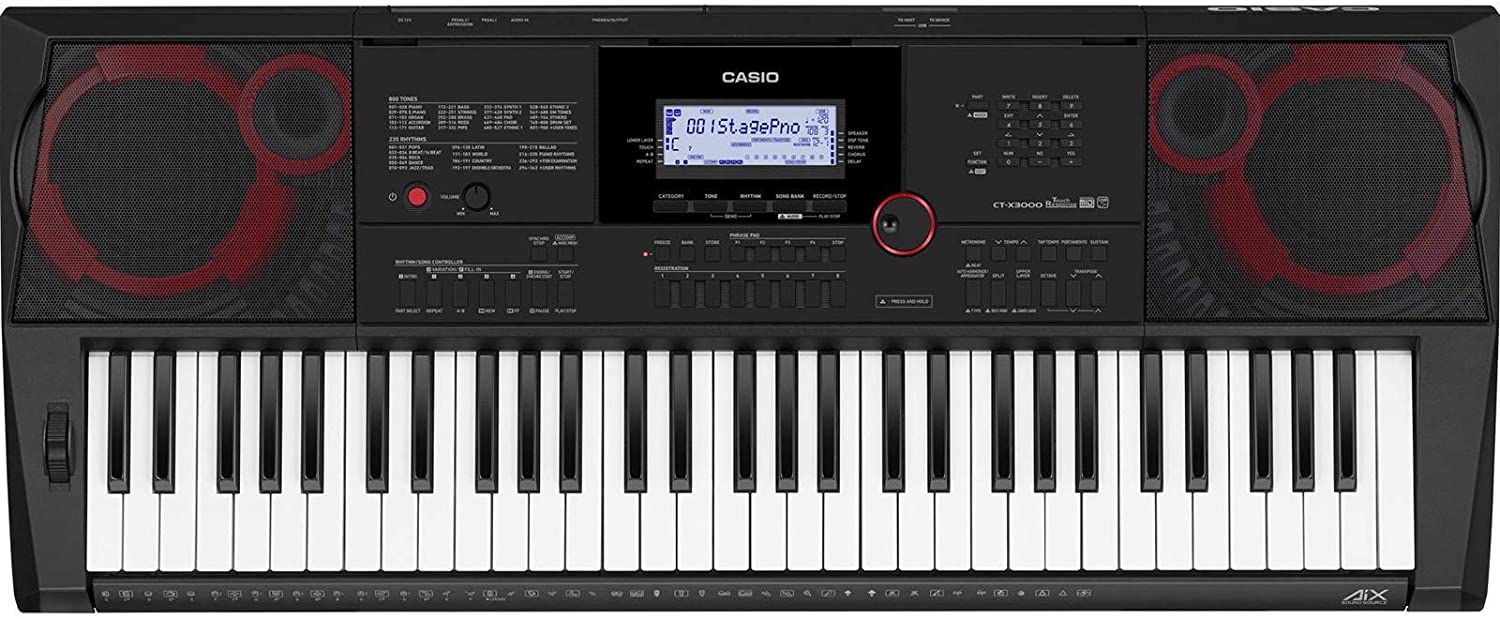
The CT-X3000 is a step up in Casio’s lineup from many of the entry-level keyboards. It features a 61-key board with three types of touch responses and three sensitivity options, so you can dial in the perfect feel as you play. It also comes with robust built-in speakers that offer relatively good sound quality without adding an external amp.
What really sets this keyboard apart is its library of tools for producers. The keyboard comes with an incredible 800 tones and 235 rhythms, all of which can be edited. It also supports MIDI, so you can connect this keyboard to almost any common track recording software on your computer via USB.
Users found that the display and controls take some time to get used to, especially if this is your first keyboard. The LED display is large, but crowded with information and has a lot of different menus. However, with some practice, users noted that it becomes easier to understand.
More features: 17-track recorder; multiple built-in digital effects; recording of up to 5 songs; 16 track song sequencer; stores up to 32 set ups

If you’re looking for a Casio keyboard to record your favorite songs and dive deep into music production, we think the WK-6600 is one of the best options in Casio’s lineup. It’s not quite a full keyboard, but the 76 keys offer all the range that most scores require. Users also love that the piano-style keys simulate the action of traditional acoustic piano keys and can be customized with 2 different sensitivity levels.
The keyboard features 700 tones, 210 rhythms, and 10 reverb settings. It also comes with a 16-track song sequencer that allows you to record up to 30,000 notes to the keyboard’s built-in memory. The Tone Editor is also a unique feature for producers that allows you to modify the attack and release time for different tones to create unique sounds.
As we’d expect from a semi-professional keyboard, this model is MIDI-compliant and can be connected to your computer for track editing via USB.
More features: Chordana Play App integration, Bluetooth compatible; illuminated touch sensor controls; 60 songs included and 10 song expansion; many digital effects built-in

This full-size, 88-key keyboard from Casio is the perfect hybrid between an advanced keyboard and a professional-quality digital piano. The keys are weighted using Casio’s smart scaled hammer action technology, and you can further modify the responsiveness of the keyboard with five sensitivity settings.
The keyboard is a relatively good option if you need a portable piano for playing shows. Although it features a full-sized board with weighted keys, it weighs in at 25 pounds and is just over 4 feet long. It comes with an AC adapter, but can also be powered using batteries.
This keyboard isn’t designed primarily with music production in mind, as it only has 18 tones included. That said, it integrates with the Chordana Play app for iOS and Android using Bluetooth. It also supports track recording via MIDI and has a library of digital sound effects built in.
More features: Dance Music Mode; Virtual Hall; Chordana Play app; 46 World Rhythms

The CTK-2550 is an excellent choice for beginners looking for their first keyboard. This model has 61 keys and offers 48-note polyphony. In addition, for a relatively low price, it comes with everything you need to start playing – including a stand, power supply, and headphones.
This keyboard is extremely portable, which is a plus if you’re looking for something you can move between your home and practice sessions or shows. It weighs just 7 pounds and runs on batteries if you want to leave the power supply at home.
The keyboard is compatible with the Chordana Play app for iOS and Android devices. However, beware that it doesn’t have Bluetooth support, so the only way to connect a device is via aux cable. Many newer iPhone and Android devices don’t have aux cable inputs, in which case you’re out of luck.
More features: 10 integrated songs; striking change-over switch between piano and organ modes; LSI sound source
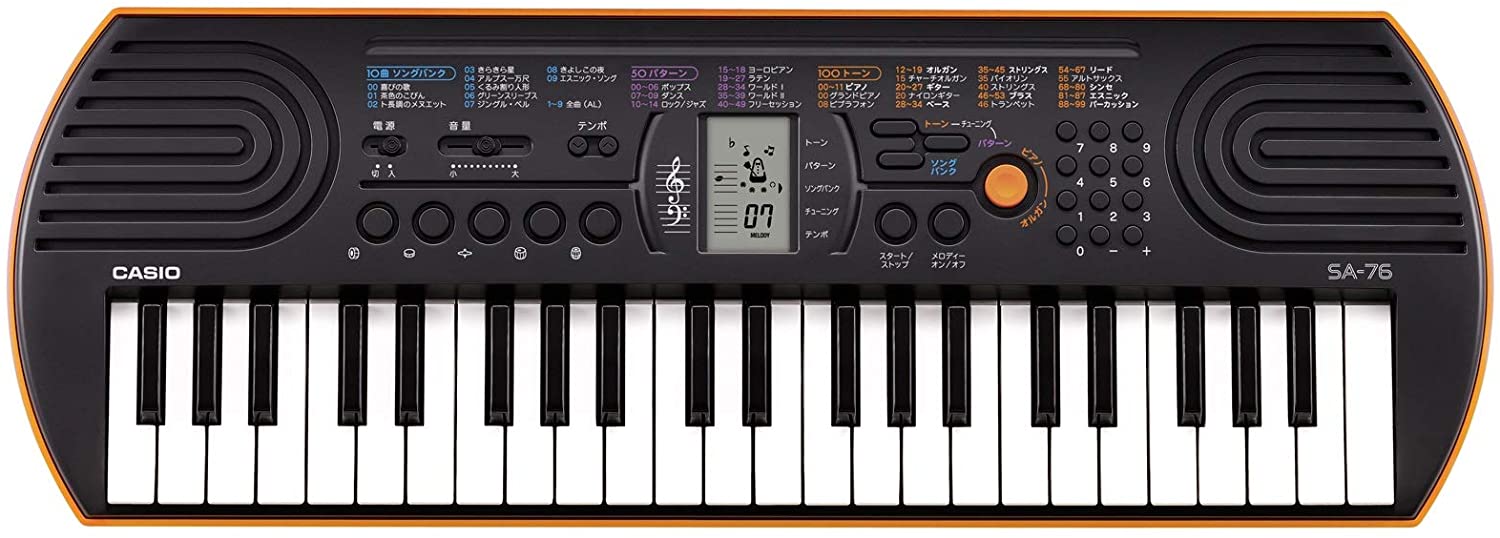
The SA-76 is our pick for the best Casio keyboard for kids. This compact keyboard is built with 44 miniature keys, which are slightly narrower than standard piano keys and easier for children with small hands to navigate. There are only two full octaves on the keyboard, but this is plenty for beginners who are just learning to play music.
The keyboard only supports polyphony of 8 notes at a time, but that’s one of its few shortcomings. Casio loaded this keyboard with 100 different tones and 50 different rhythms, plus 10 songs. The LCD display is more basic than some of the displays Casio uses on its more advanced keyboards, but it’s easy to navigate and enables easy switching between piano and organ modes.
The keyboard can be powered with either batteries or a power adapter, but note that the power adapter is sold separately. That said, users noted the batteries last for months at a time with moderate use.
More features: Key Lighting system; 60 built-in songs; connects to Chordana Play iOS/Android app

The LK-S250 is one of the best Casio keyboards for beginners. While you can buy the keyboard alone, we recommend the educational bundle that includes an AC power supply, stand, headphones, and computer-based music lessons. It’s very inexpensive, especially given the quality of this keyboard.
The keyboard has as 61-key board, which is more than a broad enough range for most musicians just starting out. Casio built in 400 tones and 77 rhythms along with 60 songs, so there are plenty of options to help you get started. We also like the lighting key system, which lights up the keys to play for any of the 60 built-in songs. This feature is particularly helpful for beginners who may not be able to read sheet music fluently. In fact, this is one of the best Casio lighted keyboards available.
This keyboard also connects to the Chordana Play app for iOS and Android. However, you’ll need an aux cable connection since the keyboard doesn’t support Bluetooth.
More features: built-in grip for portability; switch between piano and reed organ/organ sound; 10 play-along tracks; retro design
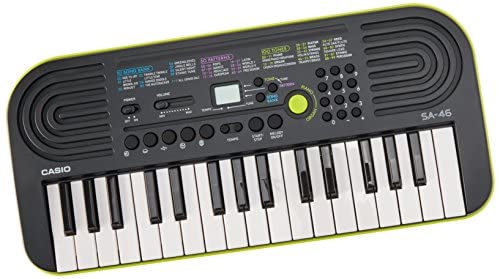
If you’re looking for a portable Casio keyboard, we recommend giving the SA-46 a closer look. This keyboard is extremely small, with just 32 miniature keys. It only includes a single octave, so it’s probably not a great option for playing complex music. But, at under 3 pounds and less than 2 feet long, it’s extremely easy to take with you anywhere and can enable you to keep practicing on the go.
The keyboard boasts many of the same features as the slightly larger SA-72, including 100 tones and 50 rhythms. However, the LCD screen is somewhat smaller and doesn’t show notes in notation form as they’re played.
Users were pleasantly surprised with the quality of the speakers on this keyboard, even though they’re small and don’t offer much volume. With just 32 keys, you won’t be playing many complex chords – so the fact that this keyboard only offers polyphony of 8 notes at a time isn’t a huge problem.
Now that you know more about our 12 favorite Casio keyboards, how do you choose which one is right for you? There’s a lot to think about when it comes to picking a new keyboard or digital piano, not the least of which is what you’re hoping to get out of your new instrument. In our buying guide, we’ll cover everything you need to know about how to pick the best keyboard for your needs.
Although there are many keyboard brands on the market, Casio makes some of the most highly rated and well-loved digital pianos around. The company has been in the keyboard manufacturing business for decades and is on the forefront of introducing ever more advanced technical capabilities throughout its keyboard range. For example, you’ll find hundreds of tones, rhythms, and sound effects across the models we reviewed, as well as support for computer connectivity and recording.
On top of that, Casio’s selection of digital pianos is simply enormous. Whether you’re looking for a compact keyboard for a beginner pianist or a full-size model for an expert musician, Casio has a model to offer. Our review covered both Casio keyboards and Casio digital pianos, as well as a number of models that straddle the line between these two types of instruments.
Casio also gets a lot of credit for standing behind its products. All Casio digital pianos come with a one-year warranty, which can be extended up to 5 years for some models. In addition, Casio offers technical support 6 days a week.
Although the terms keyboard and digital piano are often used interchangeably, they actually refer to different types of instruments.
A digital piano – like the Privia PX-770, the Privia PX-870, or the CGP-700 – are designed to mimic the feel and sound of a traditional acoustic piano. Digital pianos have weighted keys and often only produce the sounds that a traditional piano could make. They tend to be best for musicians who want to reproduce the sound and feel of a traditional piano or to record music that was written for an acoustic piano. It’s also worth noting that digital pianos are more expensive than the typical keyboard.
Keyboards are designed to make a much wider range of sounds than a traditional or digital piano ever could. For example, more advanced models like the WK-6600 and CT-X3000 have hundreds of tones available. Unlike digital pianos, keyboards don’t have weighted keys and they tend to be more compact and portable.
Keyboards can be a good choice for beginners because they are relatively affordable, but more advanced models can also be used by music producers.
When it comes to choosing the right Casio keyboard or digital piano for your needs, there’s a lot to consider. Here, we’ll take a closer look at some of the key factors you should think about when comparing models.
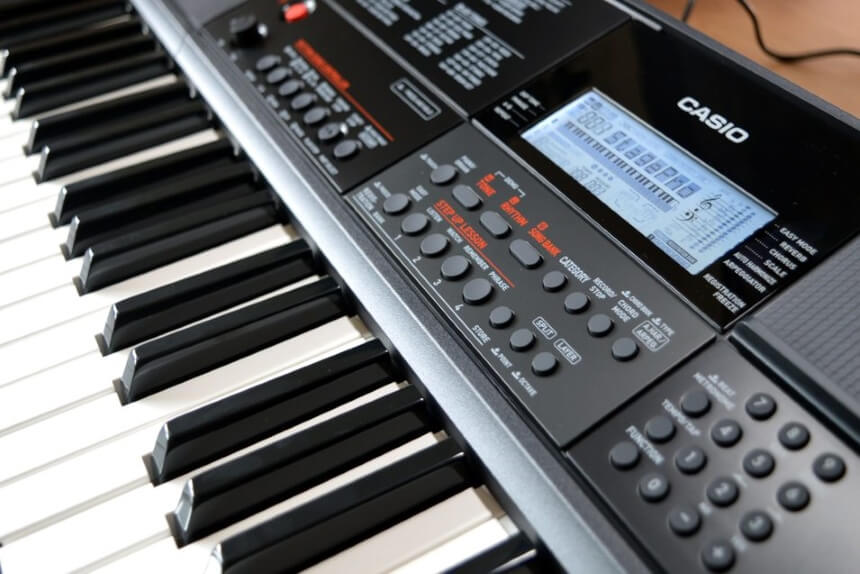
Traditional full-size acoustic pianos have 88 keys, so this is the number you’ll find on digital pianos like the Privia PX-770, the Privia PX-870, and the CGP-700. Most keyboards, though, have fewer keys to make them more compact and affordable. For example, the CT-X3000, LK-S250, CT-X700, and CT-S300 have 61 keys, and especially compact models like the SA-46 has 32 narrow keys.
While most keyboards don’t have weighted keys, you can find this option in some models. For example, the PX-S1000 offers five adjustable sensitivity levels and the WK-6600 offers two sensitivity levels.
Polyphony describes the number of notes a digital keyboard can make at one time. If you’re playing a chord, for example, you may need to play 3 or 5 notes at a time.
Many of the Casio keyboards we reviewed have a polyphony of at least 48 notes, which is far more than most pianists will ever need. Some digital keyboards are capable of more than 100 notes at the same time. However, if you opt for a beginner model like the Casio SA-76 or SA-46, keep in mind that you can’t play five-finger chords with both hands at the same time since these keyboards only offer a polyphony of 8 notes.
Casio keyboards and digital pianos are built with preset tones that allow you to change the sound of your piano. This might not be important if you’re just looking to imitate the sound of a traditional acoustic piano, but if you’re using your keyboard for music production or specialized sound effects tones can matter a lot.
Unless you’re an experienced producer, don’t get too wrapped up in comparing the total number of tones across keyboards. Chances are, you’ll only ever use a handful of the tones available. So, for example, the 400 tones available on the CTK-2550 and LK-S250 are more than most pianists will ever need.
Keep in mind that digital pianos tend to have far fewer tones than keyboards. The tones available on a digital piano are typically piano-related tones, such as bright or dark. In contrast, the tones on a keyboard might cover a much wider range of styles, such as mimicking an electric guitar or bass.
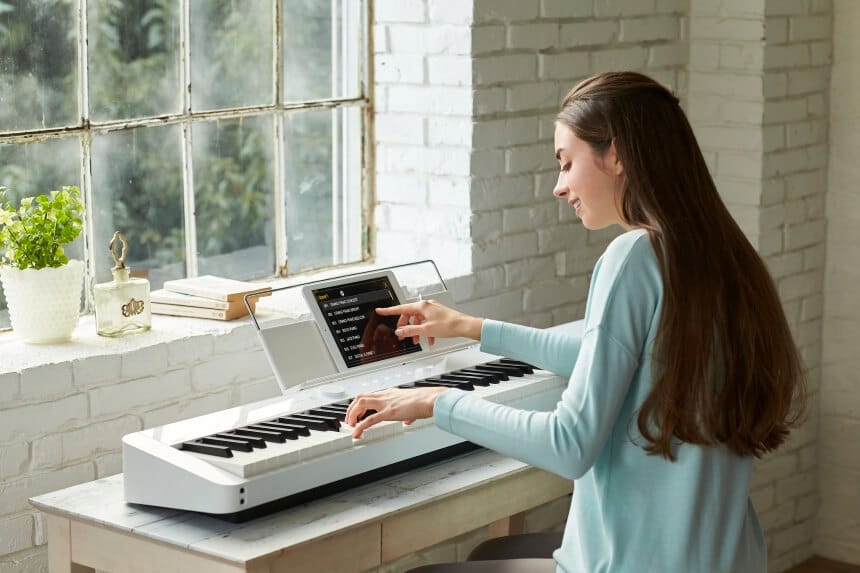
Many of Casio’s digital pianos don’t include rhythms, since they’re used more by beginners and producers.
Effects are sound effects that you can add on top of the music you’re playing on your keyboard. Casio keyboards like the PX-S1000 and WK-6600 come with dozens of built-in effects, but many beginner models leave these out since they’re primarily used by more advanced producers.
The display screen on your digital keyboard is often small but important. This screen will help you navigate through your keyboard’s various tones, rhythms, effects, and other options. Casio displays typically offer backlighting so that you can better see the options as you’re changing effects. Otherwise, the display is meant to stay out of your way while you play.
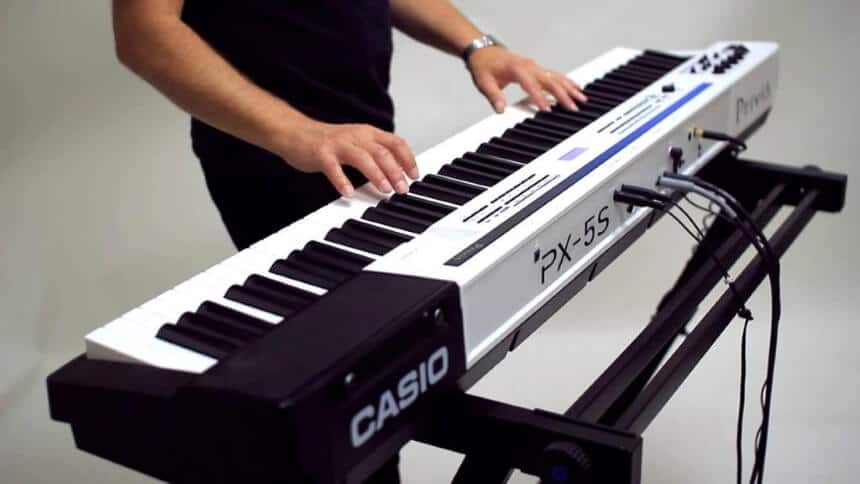
Modern keyboards also typically support USB connectivity so that you can pair your keyboard with your computer. This is important because it allows you to download new effects and rhythms or to record a piece to your computer. Especially if you plan to use your keyboard for music production, USB connectivity is a must.
Finally, some keyboards like the PX-S1000 can also connect to your computer or smartphone via Bluetooth. However, this still isn’t a common feature among Casio keyboards.
Most of Casio’s larger keyboards must be plugged into a standard wall outlet and require an AC adapter for power. This typically isn’t a problem if your keyboard is set up in a single place. However, small models like the SA-46 can also run on batteries, which makes them easier to transport. The SA-46 also has a power adapter available so you don’t have to spend money on batteries.
The dimensions and weight of your keyboard are important to consider, especially if you plan to travel to shows with it or need to store it when not in use. In fact, portability is one of the main reasons to opt for a keyboard with fewer than 88 keys.
If you’re tight on space, be sure to measure the area where you plan to set up your keyboard and make sure it will fit – stand included.
As you might expect, keyboards with more keys tend to be heavier. In addition, digital pianos that have weight keys and built-in stands can be significantly heavier than Casio’s keyboard offerings. Still, the weight isn’t extreme, especially compared to traditional acoustic pianos. The heaviest Casio digital piano we reviewed, the PX-870, weighs in at 74 pounds.
It’s also important to think about what accessories you’ll need with your keyboard or digital piano. Unfortunately, Casio doesn’t throw in many freebies with its keyboards, although you may be able to find a bundle deal.
To start, you’ll need a stand for most Casio keyboards. The good news is that most keyboard stands will fit most Casio keyboards. If you opt for a small 32-key keyboard like the SA-46 or SA-76, you might need a smaller than standard keyboard stand.
If you’re opting for a digital piano, consider adding pedals to further replicate the feel and sound of a traditional piano. Some models, like the Privia PX-870, come with pedals built into the piano. Others, like the CGP-700, require you to purchase compatible pedals separately.
Our favorite Casio keyboards on the market today are the CT-X700, the CGP-700, and Privia PX-870.
The Privia PX-870 is one of Casio’s most advanced digital pianos, featuring tri-sensor weighted keys, a beautiful stand with integrated speakers, and a 60-song music library with room for track recording. It’s not cheap, though, so this digital piano is best for musicians who are looking to upgrade or want an alternative to a traditional piano.
The CGP-700 blurs the line between a digital piano and advanced keyboard. It has a full keyboard with weighted keys, but 550 built-in tones and a 5.3-inch color touchscreen display to control the keyboard’s sound.
We think the CT-X700 is the overall best Casio keyboard if you want to start playing right away. It’s affordable and lightweight, comes with 600 tones built in, and supports MIDI so you can record tracks and dive into music production.